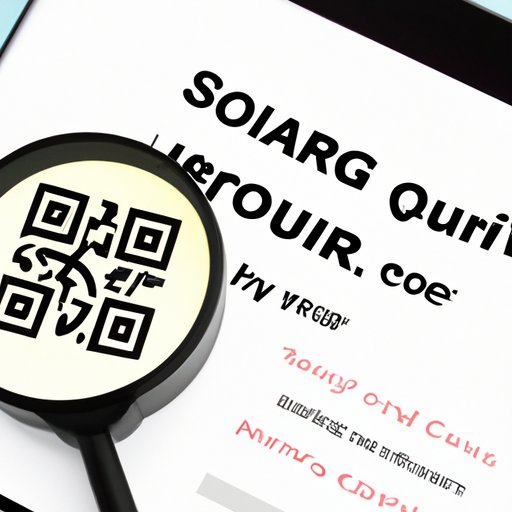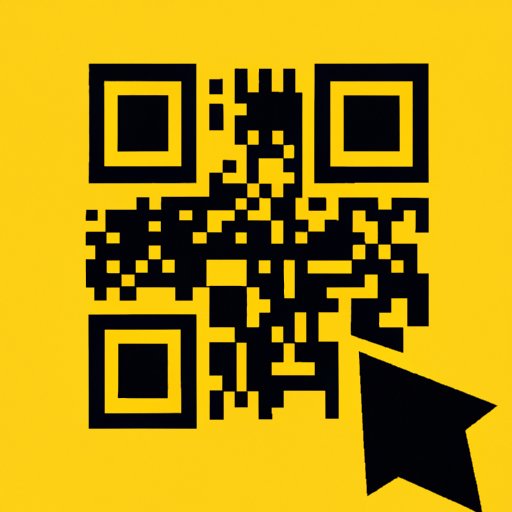I. Introduction
A QR code, or Quick Response code, is a two-dimensional barcode that can be found on everything from product packaging to flyers. It was first created in 1994 by a Japanese automotive company, but it wasn’t until recently that it rose to popularity as a form of data transfer. QR codes are an efficient way of sharing information as they can hold much more data than traditional barcodes and can be scanned quickly. Knowing how to scan a QR code can save you a lot of time and hassle. In this article, we will cover everything you need to know about scanning QR codes.
II. QR Codes 101: An Easy Way to Learn How to Scan Them
QR codes are an extension of traditional barcodes, but they can store much more information. QR codes are often used to direct users to websites and social media accounts, share contact information and Wi-Fi passwords, and offer exclusive discounts. QR codes can be found on anything from flyers to product packaging to billboards. They are commonly used for promotional purposes and are becoming more widely used as a form of payment.
The first step in scanning a QR code is to find the QR code. QR codes are often printed as black and white squares and may be found on posters, business cards, or even on clothing. Once you have found the QR code, the next step is to scan it.
In order to scan a QR code, you will need a QR code scanner app or a device with a built-in QR code scanner. If you are using a smartphone, the easiest way is to use your phone’s native camera app. Simply point your camera at the QR code, and if it is recognized, your phone will automatically prompt you to open the link or file. Alternatively, you can use a third-party QR code scanning app or a built-in scanner on a smartwatch or other wearable device.
III. Different Methods to Scan QR Codes
There are several ways to scan QR codes, including using your phone’s native camera app, third-party QR code scanning apps, and built-in QR code scanners on smartwatches and other wearables. Each method has its own pros and cons.
A. Using your phone’s native camera app
Most modern smartphones come with a built-in QR code scanner in the camera app. All you need to do is point your phone’s camera at the QR code, and if it is recognized, your phone will prompt you to open the link or file. This method is simple and quick, and you do not need to download any extra apps. However, some older phone models may not have built-in QR code scanning capabilities.
B. Third-party QR code scanning apps
There are numerous third-party QR code scanning apps available on the App Store and Google Play. These apps can offer additional features such as the ability to save QR codes for future use. Some of the most popular QR code scanner apps include QR Reader, NeoReader, and QR Droid.
C. Built-in QR code scanners on smartwatches and other wearables
Some smartwatches and other wearables come with built-in QR code scanners. Simply activate the scanner on your device, and the built-in camera will capture the code. This method is more convenient for those who do not want to take out their phone to scan a code. However, the scanning process may be slower than using a smartphone or third-party app.
D. Comparison of the pros and cons of each method
The method you choose to scan QR codes will depend on your personal preference and the devices you are using. Using your phone’s native camera app is the easiest option and does not require any additional downloads. Third-party QR code scanning apps can offer extra features, but they may require additional storage space and processing power. Built-in QR code scanners on smartwatches and other wearables are most convenient for those who use these devices regularly.
IV. Top 5 QR Code Scanners for Easy and Accurate Readability
If you are looking for a QR code scanner app to download, here are some of the best options:
A. QR Reader
This app is available on both iOS and Android and is known for its speed and accuracy. QR Reader can scan both QR and traditional barcodes and offers in-app actions such as opening URLs and adding contacts to your address book.
B. NeoReader
Another popular QR code scanner app, NeoReader offers a clean and simple interface. It can scan a variety of barcode formats and also offers in-app actions such as sending email messages and adding calendar events.
C. QR Droid
This app is available on Android and offers a wide range of features, including the ability to generate your own QR codes. QR Droid can scan a variety of barcode formats and offers in-app actions such as calling phone numbers and opening maps.
D. ScanLife
This app is available on iOS and Android and offers a sleek and modern interface. ScanLife can scan both QR and traditional barcodes and offers in-app actions such as adding contacts to your address book and sharing links on social media.
E. i-nigma
Available on both iOS and Android, i-nigma is known for its fast scanning speeds and high accuracy. i-nigma can scan a variety of barcode formats and offers in-app actions such as sending email messages and adding calendar events.
V. Scanning QR Codes: The Basics for Beginners
Scanning a QR code is a simple process, but there are a few things you should keep in mind to ensure that the process goes smoothly:
A. Preparing your device for scanning QR codes
Make sure that your device’s camera is clean and ready to use. You should also make sure that your phone’s brightness is high enough to clearly read the QR code.
B. Positioning your device to scan QR codes
Hold your device steady and position it directly in front of the QR code. Make sure that the entire code is visible in your camera’s viewfinder.
C. Notable points to remember when scanning QR codes
Remember that QR codes can sometimes be difficult to scan if they are small, blurry, or printed on reflective surfaces. Additionally, some QR codes may not be scannable if they are damaged or distorted. If you are having trouble scanning a QR code, try adjusting your device’s position or lighting.

VI. How QR Code Scanning Could Make Your Life Easier
QR code scanning technology has the potential to make everyday life simpler and more convenient in several ways. Here are a few examples:
A. Examples of how QR code scanning can be useful in daily life
QR codes can be used to store contact information, Wi-Fi network information, and even payment information. They can also be used for event registration and ticketing.
B. Benefits of using QR code scanning in everyday activities
The main benefit of using QR code scanning is that it saves time and reduces the risk of error. For example, scanning a QR code to access a website or social media account is much faster and more accurate than manually typing in the address.
C. Impact of QR code scanning technology on different industries
QR code scanning technology is becoming increasingly important in the healthcare, transportation, and retail industries. QR codes can be used to share patient information, track shipments, and access online shopping discounts.
VII. QR Code Scanners: The Future of Shopping in Your Pocket
QR code scanning technology is changing the way we shop. Here are a few examples of how QR codes are used in the retail industry:
A. Explanation of how QR code scanning technology works in the retail industry
QR codes can be used to offer exclusive discounts and promotions to customers. They can also be used to provide product information and reviews.
B. Advantages of using QR codes in shopping
The main advantages of using QR codes in shopping include convenience and speed. Customers can quickly and easily access product information and discounts without the need for a salesperson.
C. Future potential of QR code scanning technology
The future of QR code scanning technology is bright. It is expected that QR codes will become even more widely used as a form of payment, and that they will continue to be important in industries such as healthcare and transportation.
VIII. Conclusion
Scanning QR codes is a simple but important skill that can save time and hassle. Whether you are using your phone’s native camera app or a third-party scanner, it is essential to know how to scan QR codes. QR code scanning technology has the potential to make everyday life easier and more convenient, and it is changing the way we shop and access information. We hope that this guide has provided you with a comprehensive understanding of QR codes and how to scan them.
